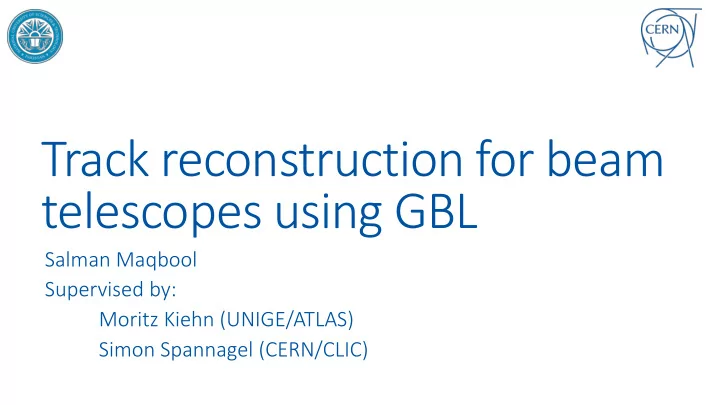

Track reconstruction for beam telescopes using GBL Salman Maqbool Supervised by: Moritz Kiehn (UNIGE/ATLAS) Simon Spannagel (CERN/CLIC)
About Me Summer Student at CERN Bachelor’s in Mechanical Engineering + Master’s in Robotics from National University of Sciences and Technology (NUST), Pakistan Majoring in Computer Vision and Deep Learning
allpix² Simulator for detector behavior under a particle beam Rewrite from scratch of the allpix framework Easy to use: Specify experiment parameters like detector models ls, tele lescope configuration, beam propertie ies using simple configuration files Used to generate Monte Carlo truth for track reconstruction Worked on the RCEWriter module which outputs files compatible with Proteus track reconstruction framework
allpix²
allpix²
Proteus Framework for track fitting, reconstruction, and analysis for beam telescopes Combines neighboring hits into clusters Combines clusters at each sensor into tracks Used a least squares fit for reconstruction, which limited reconstruction accuracy Didn’t take into account effects of multiple scattering
General Broken Lines (GBL) Fast and efficient algorithm which takes into account effects of multiple scattering A seed trajectory is corrected based on the difference between the track projections on the sensor planes and the actual measurements Multiple scattering and measurement uncertainties are modeled using covariance matrices, which are propagated along the sensor planes Kleinwort, Claus. "General Broken Lines as advanced track fitting method." Nuclear Instruments and Methods in Physics Research Section A: Accelerators, Spectrometers, Detectors and Associated Equipment 673 (2012): 107-110.
GBL and Proteus
GBL and Proteus
GBL and Proteus
GBL and Proteus
Takeaway Configured and ran simulations for FEI4 telescope setup Extended allpix^2 to get the desired output for reconstruction Extended Proteus to include reconstruction using GBL
Recommend
More recommend